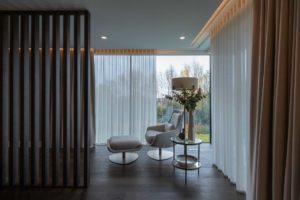Lighting design should be a key consideration when undertaking a property build or refurbishment. Get it right and correctly specified and positioned fittings will enhance the building aesthetically and functionally too. Get it wrong and your home might never look or feel as you’d hoped, with fittings jarring against the building, and at worst, leaving areas with lack-lustre illumination.
Lighting design can certainly make or break a property, it is important that the fittings specified, and their locations, are carefully considered. Modern or more traditional homes need to be designed differently to ensure that the lighting complements the overall aesthetic, highlighting key architectural features and complimenting the space. In this blog we’ve summarised the key lighting design do’s and don’ts, that’ll help your project go smoothly.
Positioning
With careful consideration from the outset, it is possible to avoid falling into the trap of peppering your ceilings with rows of evenly spaced downlights. Although this will give you a good spread of light, it won’t ever create any interest or drama in a space. Instead consider the room layout and where furniture will be, position your light fittings appropriately to that.
Pairs of downlights work well and look more considered above console tables, in the corners of the room and over seating. They’ll ensure you get pockets of light in the key areas, while leaving other areas with less light from above, perfect for floor lamps or wall lights to be used.
Layering
It is important to have multiple layers of lighting in any room, from low level table lamps or accent lighting beneath cabinetry, through to wall lights, floor lamps or suspended pendants. If it is aesthetically suitable for the space, then in-ceiling downlights are a great option too.
Different fitting types should be grouped into circuits, separated from each other, the feel of the space can then be drastically changed by adjusting them independently. A room can be an intimate cosy space for relaxing, through to a well-lit, practical space for working, all at the touch of a button.
Colour temperature
With older incandescent lamps, the colour of the emitted light would change as the intensity was lowered, from a bright white at high intensities to a warm orange glow when dimmed. Most LED lamps don’t work in this way, maintaining the same colour as they are dimmed, which makes it important to select the correct ‘colour temperature’ to suit your needs.
3000K or above is considered to be a cold blueish white, great for working spaces but not suited to relaxing. 2700K is a warmer colour and has become the standard ‘warm white’ for many projects. As you move down to 1800K you’ll see a very warm orange colour, which can create a good effect in accent lights for those cosey little rooms where you hunker down in winter. Technology moves on at a pace and LEDs that subtly change the colour temperature as they are dimmed have been around for some time.
The latest trend is for tuneable white lighting, which allows the colour temperature to be proactively changed to suit your own needs in a space at any given time.
Natural light
Consider the way that natural light enters a space through the windows too, and spend some time in the room to see how the natural light changes throughout the day. It may will be that you need to consider installing lights on the same wall as the windows. As the last few hours of sun enter the room, that wall might drop into shadow and benefit from some table lamps or wall lights to balance the space.
Feature pendants are one of the best ways to create a design statement but could potentially cast shadows during the day too, so give some thought as to how that might look, you may want to consider locating those to the sides of the windows, rather that centred on them.
Control
In a larger home, it’s important to consider how you make the lighting system simple to use. A lighting control system, such as Lutron, is often a key feature as intuitive keypads, in place of ordinary light switches, can be set up to control any lighting within your home.
Useful examples might be a ‘hello’ button by the front door for when you enter the property. This one button can illuminate all the hallways and corridors and ensure that your most commonly used rooms are already illuminated perfectly for you. Similarly, a ‘goodbye’ button or‘goodnight ‘ button at the bedside can ensure all the lights are turned off, which means you no longer need to tour the house to turn everything off before you go to bed or leave the house.
These keypads recall perfectly configured lighting scenes within each room too, buttons labelled as ‘evening’ can ensure that your room is set up perfectly for relaxing, without the complexity of multiple light switches or wall mounted dimmers.
For advice on lighting design and control in your home, get in touch with our expert design team today enquiries@cleverass.com




